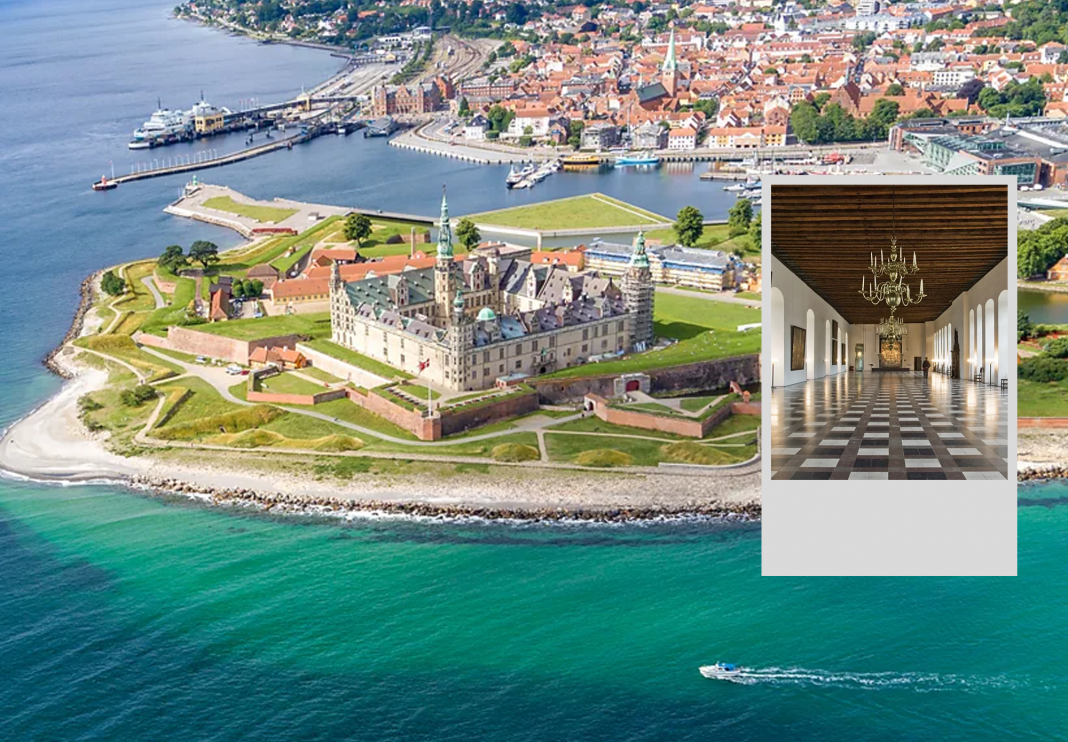As the Royal Shakespeare Company and Radiohead join forces to reimagine Hamlet, a visit to Kronborg Castle in Denmark—the iconic setting of Shakespeare’s tragedy—unveils a deeper connection to the play’s haunting atmosphere and timeless themes.
A ghostly beginning at Kronborg castle
A biting wind sweeps across the Øresund Strait as I stand before Kronborg Castle in Helsingør, Denmark, gazing out toward Sweden. The red guard post beside ancient cannons marks the very spot where Shakespeare’s Hamlet begins — with the two sentinels, Francisco and Bernardo, on watch, haunted by the ghost of the late king. The imposing Renaissance fortress, built in 1574, rises behind me with its turrets, moat, and stately banquet hall, the perfect stage for a drama steeped in intrigue, betrayal, and tragedy.
This year, the Royal Shakespeare Company (RSC) brings a remarkable trilogy of Hamlet productions: a radical adaptation scored by Radiohead’s Hail to the Thief album; Fat Ham, a comic retelling set in the Deep South; and a traditional rendition starring Luke Thallon. Tamara Harvey, RSC co-artistic director, notes, “There’s something in the air right now saying that the play has resonance,” as themes of shifting generational power and societal unease echo eerily in today’s world.
The eeal Elsinore: History and legend of Kronborg
Modern-day Helsingør, once Shakespeare’s Elsinore, looks far from “rotten.” Blue skies and a golden flag flutter atop the castle’s turret as castle guide Louise Older Steffensen leads me through echoing stone corridors into the grand ballroom, where tapestries from the era shimmer with gilded kings and queens. Though Shakespeare likely never visited Kronborg himself, evidence shows his company’s actors performed here for the Danish court in the late 16th century, bringing tales that may have inspired the play’s rich setting.
A uniquely theatrical tradition once echoed through these halls: a ceremonial toast punctuated by a kettle drum, trumpet, and cannon fire — mirrored in Hamlet. The castle’s intimate details — from silk-draped queen’s chambers to vast galleries where ladies’ dresses once rustled — immerse visitors in the drama’s atmosphere. Seasonal murder mystery tours and Halloween ghost hunts add to the castle’s aura, though the famed ghost of Hamlet’s father remains elusive.
Shakespeare’s Danish connection and royal patronage
History deepens the castle’s significance. When King James I of England married Danish princess Anne in 1589, Denmark’s royal residence gained importance across Europe. Following Elizabeth I’s death in 1603, James ascended the English throne, cementing the union. As Steffensen explains, “The first quarto of Hamlet was set in Denmark, but without specific locations. After Anne became queen, references to Kronborg itself appeared.”
King James became patron to Shakespeare’s troupe, renaming them “The King’s Men.” The Danish queen’s castle thus became not just a backdrop but a symbolic heart of the play, intertwining history, politics, and art in a single site.
Hamlet’s living legacy in Helsingør
Climbing the castle’s cannon tower, I overlook the moat, barracks, and the town that pulses with Shakespearean spirit. Inside a former infirmary turned Shakespeare Festival headquarters, Lars Romann Engel, CEO and artistic director of HamletScenen, shows me portraits of legendary Hamlets — Jude Law, Kenneth Branagh, Richard Burton, and more — honoring decades of performances that have defined the town’s cultural renaissance.
Following the collapse of Helsingør’s shipbuilding industry in the 1980s, the Hamlet Festival helped revitalize the community by staging innovative productions on the castle grounds every August. Open-air performances of Hamlet and a lighter Shakespeare comedy draw audiences who picnic beneath the stars, transforming the historic fortress into a vibrant cultural hub.
Engel’s own 2008 adaptation set amid the castle’s ruins, starring Claes Bang, was pivotal in establishing the festival’s reputation. “When you see Hamlet here,” Engel says, “you know you enter the myth. You’re at the epicentre. It’s a special thing: it was actually here that it was written for.”
Myth, mystery, and modern interpretations
The castle’s cellar labyrinth holds a surprising neighbor to Shakespeare’s statue: Holger Danske, the legendary Viking warrior said to awaken when Denmark is in peril. This blend of myth and history enriches the visitor experience, where legend and literature converge.
This year’s festival (6-24 August) embraces both classical and contemporary interpretations, including a traditional all-male cast from The Lord Chamberlain’s Men and Eddie Izzard’s one-person Hamlet. Engel observes, “When the world feels edgy, people crave the familiar — but the play’s endless reinvention keeps it alive.”
Tamara Harvey echoes this sentiment: “Hamlet wrestles with the human condition with such complexity that it resonates differently for everyone.” And to witness the play where it was born — within Kronborg’s fortress walls — is to experience Shakespeare’s tragedy as never before.
Walking through the drama
As I leave Kronborg Castle, crossing the moat’s bridge past the guardhouse and grassy fortifications, the distant echo of marching feet from a hidden sound system draws me back into Hamlet’s world. The prince’s funeral procession plays out in my imagination, a poignant reminder of a play that continues to haunt and inspire 425 years on.
Visiting Kronborg is more than a history lesson: it is a journey into the heart of a timeless masterpiece, where stone and story merge and Shakespeare’s ghost still lingers in the cold Danish wind.



